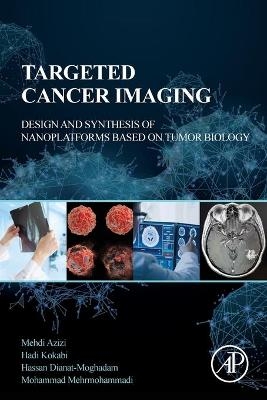
Targeted Cancer Imaging
Academic Press Inc (Verlag)
978-0-12-824513-2 (ISBN)
Although considerable efforts have been conducted to diagnose, improve and treat cancer in the past few decades, existing therapeutic options are insufficient, as mortality and morbidity rates remain high. One of the best hopes for substantial improvement lies in early detection. Recent advances in nanotechnology are expected to increase our current understanding of tumor biology, allowing nanomaterials to be used for targeting and imaging both in vitro and in vivo experimental models.
Mehdi Azizi obtained his B.Sc. (Chemistry) from Razi University, Iran in 2012, and M.Sc. (Medical Nanotechnology) from Tehran University of Medical Sciences, Iran in 2016. He is currently a Ph.D. candidate in the Medical Nanotechnology department at Tabriz University of Medical Sciences, and working with Dr. Mohammad Mehrmohammadi group at biomedical imaging department of Wayne state University. His current research include synthesis, development and application of smart theranostic nanoplatforms.Mehdi Azizi obtained his B.Sc. (Chemistry) from Razi University, Iran in 2012, and M.Sc. (Medical Nanotechnology) from Tehran University of Medical Sciences, Iran in 2016. He is currently a Ph.D. candidate in the Medical Nanotechnology department at Tabriz University of Medical Sciences, and working with Dr. Mohammad Mehrmohammadi group at biomedical imaging department of Wayne state University. His current research include synthesis, development and application of smart theranostic nanoplatforms. Hadi Kokabi graduated in 2013 from Hamadan University School of Dentistry in Hamadan Iran. He completed his Postgraduate Periodontal Residency in 2018 at Tabriz University School of Dentistry in Tabriz, Iran. He is currently Assistant professor in Department of Periodontology, School of Dentistry, Hamadan University of Medical Sciences, Hamadan, Iran. His current research include oral health, biomaterial and Nanobiomaterials in Clinical Dentistry Hassan Dianat-Moghadam received his B.Sc. degree in Medical Laboratory Sciences from the Shiraz University of Medical Sciences, Shiraz, Iran, M.Sc. in Medical Biotechnology from the Tehran University of Medical Sciences, Tehran, Iran, and Ph.D. in Medical Biotechnology from the Tabriz University of Medical Sciences, Tabriz, Iran. Mohammad Mehrmohammadi is an assistant professor of Biomedical/Electrical and Computer Engineering at Wayne State University. He received his B.Sc. degree in Electrical Engineering from Sharif University of Technology (Tehran, Iran), the M.Sc. in Electrical and Computer Engineering from Illinois Institute of Technology (Chicago, IL), and the Ph.D. in Biomedical Engineering from the University of Texas at Austin (Austin, TX). His doctoral research at Ultrasound Imaging and Therapeutics Laboratory at UT Austin was focused on design and development of novel ultrasound-based molecular imaging. Prior to joining WSU, Mohammad worked at Mayo Clinic College of Medicine (Rochester, Minnesota) as a Senior Research Fellow where his research was mostly focused on development and clinical evaluation of various ultrasound-based tissue elastography methods for applications such as bladder poor compliance diagnosis, and thyroid and breast cancer. Mohammad is the recipient a number of awards such as DOD breakthrough award (Breast Cancer Program - 2017), College of Engineering excellence in teaching award (2017), and Karmanos Cancer Institute pilot research grant (2017). Mohammad is a member of editorial board for a number of a number of journals including Ultrasound in Medicine and Biology and Medical Physics and serves a technical committee member for Acoustical Society of America (ASA) and SPIE Medical Imaging conferences. He is a member of institute of Electrical and Electronics Engineers (IEEE, UFFC and EMBS society), International Society for Optical Engineering (SPIE), World Molecular Imaging Society (WMIS), American Association for Cancer Research (AACR) and Sigma Xi.
1. Introduction 2. Passive Targeting 3. Active targeting 4. Tumor-Specific Imaging Probes in Clinical Trials 5. Challenges and Future Directions
| Erscheinungsdatum | 13.12.2021 |
|---|---|
| Zusatzinfo | 55 illustrations (20 in full color); Illustrations |
| Verlagsort | San Diego |
| Sprache | englisch |
| Maße | 152 x 229 mm |
| Gewicht | 340 g |
| Themenwelt | Medizin / Pharmazie ► Medizinische Fachgebiete ► Onkologie |
| Medizin / Pharmazie ► Medizinische Fachgebiete ► Pharmakologie / Pharmakotherapie | |
| Technik ► Umwelttechnik / Biotechnologie | |
| ISBN-10 | 0-12-824513-1 / 0128245131 |
| ISBN-13 | 978-0-12-824513-2 / 9780128245132 |
| Zustand | Neuware |
| Haben Sie eine Frage zum Produkt? |
aus dem Bereich


